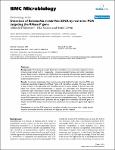Detection of Balamuthia mandrillaris DNA by real-time PCR targeting the RNase P gene
Kiderlen, Albrecht
Radam, Elke
Lewin, Astrid
Background: The free-living amoeba Balamuthia mandrillaris may cause fatal encephalitis both in immunocompromised and in – apparently – immunocompetent humans and other mammalian species. Rapid, specific, sensitive, and reliable detection requiring little pathogen-specific expertise is an absolute prerequisite for a successful therapy and a welcome tool for both experimental and epidemiological research. Results: A real-time polymerase chain reaction assay using TaqMan® probes (real-time PCR) was established specifically targeting the RNase P gene of B. mandrillaris amoebae. The assay detected at least 2 (down to 0.5) genomes of B. mandrillaris grown in axenic culture. It did not react with DNA from closely related Acanthamoeba (3 species), nor with DNA from Toxoplasma gondii, Leishmania major, Pneumocystis murina, Mycobacterium bovis (BCG), human brain, various mouse organs, or from human and murine cell lines. The assay efficiently detected B. mandrillaris DNA in spiked cell cultures, spiked murine organ homogenates, B. mandrillaris-infected mice, and CNS tissue-DNA preparations from 2 patients with proven cerebral balamuthiasis. This novel primer set was successfully combined with a published set that targets the B. mandrillaris 18S rRNA gene in a duplex real-time PCR assay to ensure maximum specificity and as a precaution against false negative results. Conclusion: A real-time PCR assay for B. mandrillaris amoebae is presented, that is highly specific, sensitive, and reliable and thus suited both for diagnosis and for research.
Related Items
Show related Items with similar Title, Author, Creator or Subject.
-
2007-05-25ZeitschriftenartikelFepA- and TonB-dependent bacteriophage H8: receptor binding and genomic sequence. Rabsch, Wolfgang; Ma, Li; Wiley, Graham; Najar, Fares Z.; Kaserer, Wallace; Schuerch, Daniel W.; Klebba, Joseph E.; Roe, Bruce A.; Gomez, Jenny A. Laverde; Schallmey, Marcus; Newton, Salete M. C.; Klebba, Phillip E.H8 is derived from a collection of Salmonella enterica serotype Enteritidis bacteriophage. Its morphology and genomic structure closely resemble those of bacteriophage T5 in the family Siphoviridae. H8 infected S. enterica ...
-
2005-06-20ZeitschriftenartikelViral promoters can initiate expression of toxin genes introduced into Escherichia coli Lewin, Astrid; Mayer, Martin; Chusainow, Janet; Jacob, Daniela; Appel, BerndBackground: The expression of recombinant proteins in eukaryotic cells requires the fusion of the coding region to a promoter functional in the eukaryotic cell line. Viral promoters are very often used for this purpose. ...
-
2013-08-08ZeitschriftenartikelCytomegalovirus Downregulates IRE1 to Repress the Unfolded Protein Response Stahl, Sebastian; Burkhart, Julia M.; Hinte, Florian; Tirosh, Boaz; Mohr, Hermine; Zahedi, René P.; Sickmann, Albert; Ruzsics, Zsolt; Budt, Matthias; Brune, WolframDuring viral infection, a massive demand for viral glycoproteins can overwhelm the capacity of the protein folding and quality control machinery, leading to an accumulation of unfolded proteins in the endoplasmic reticulum ...

